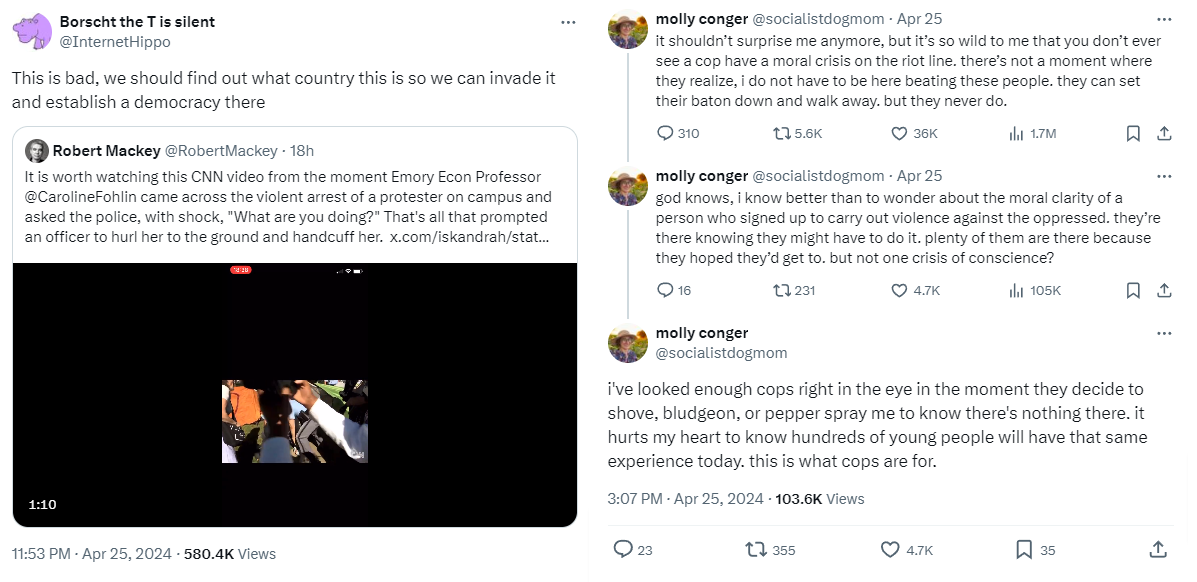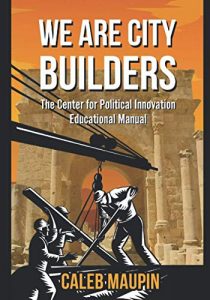Your browser is not compatible with this application. Please use the latest version of Google Chrome, Mozilla Firefox, Microsoft Edge or Safari.
Reverse Schadenfreude

Protests are escalating against the genocide in Gaza. For those of us who have worked towards more consciousness, the growth of anti-war/anti-imperialist activism across U.S. campuses is fantastic to see.
However, as police violence is rearing its ugly head, a concerning reaction has surfaced among people who ostensibly support these efforts (particularly in online Leftist circles), who suddenly seem like they feel alive when protestors are being beaten. They start getting excited, reposting videos from it and saying, “See? The PIGS are FASCISTS,” barely containing their glee.
This reaction is akin to a form of reverse schadenfreude; this violence becomes a thrilling confirmation of their worldview rather than a tragedy.
Finally, Serious Protests
The current wave of student protests at universities like Columbia, Northwestern, and the University of California is finally demonstrating some understanding of how to exert influence through focused action. Students are leveraging their positions locally and directly at academic institutions by shutting down campuses and demanding divestment from Israel, the Western Imperial satellite used to maintain US interests in the Middle East.
These protests are a sharp contrast to recent protests I’ve criticized, like those seen at Starbucks drive-thrus or the Holland Tunnel in NYC (both organized by PSL, which I recently critiqued as idealist). Those actions lack a direct pressure point and thus struggle to effect tangible change. Given the lack of focus, they primarily inconvenience unorganized working-class people with no power. This may spread awareness, but that isn’t automatically a good thing! Being aware of something that has intentionally made one’s day harder doesn’t create sympathy or will to join the cause. In fact, it creates aversion.
In contrast, the university protests are highly localized and apply pressure precisely where it can force political and economic shifts. This approach not only demonstrates the students’ savvy understanding of power dynamics but also serves as a potentially effective blueprint for future activism.
The most involved organizing bodies have been student groups, such as Students for Justice in Palestine (SJP), Jewish Voice for Peace (JVP), the Palestinian Youth Movement (PYM), and American Muslims for Palestine (AMP). These are less formal groups, but (at least in New York), there is funding/sponsorship coming from a nonprofit group called Westchester People’s Action Coalition Foundation (WESTPAC). Keeping in mind non-profits often have embedded agendas, this is not necessarily great, but these groups have demonstrated a competency in organizing that organizations like PSL have not.
A Sober Reality
Over the past two years, I’ve been all around the country, in cities like New York, Portland, and Washington DC, with the Center for Political Innovation, advocating vigorously against the genocide in Gaza. Our activities — marches, canvassing at universities, passing out literature, and holding events — have always aimed at constructive engagement, not confrontation. We have brought information and openness; we have courted the public.
These have fortunately all gone well, but I have been involved in demonstrations that draw police action. When this happens, the reality is stark: police violence does not inspire people to rise up; it instills fear, which sends most people running – this can dismantle the very leverage we strive to build.
The online-aware Left, influenced by the representation of past movements on Tumblr or Twitter (like GamerGate or the Alt-Right), often views police crackdowns as validation of their righteousness. This has led to a perverse celebration among some when violence occurs at student protests, mistaking these moments as opportunities to highlight state brutality. However, this reaction — sensationalized for content — misses the point.

reveling in the chaos
These folks see videos of the violence and become activated, their Content-Brained excitement on display, knowing they can indulge the negativity as well as nihilistically bask in their own correctness.

Yelling “LOOK HOW BAD THINGS ARE!” does little to advance a cause. Instead, it helps create an aversion to action that seems futile. It inspires not optimism but nihilism. Showcasing misery and oppression in this way is a navel-gazing exercise, at best. It represents the march of history as impossible rather than inevitable, reinforcing the paralysis that is so hard-fought to snap people out of.

Police violence is a serious setback. I find the perverse validation people get from it revolting. As someone who has witnessed the challenges of demonstration and disruption firsthand, snipers on the roof or riot control unleashing their rage on activists are sobering reminders of the risks we face, and I don’t revel in this – I can’t.
But we do not succeed on the “strength” of the spectacle of conflict.
Schadenfreude, Backwards
The phenomenon I’m describing can be thought of as a reverse schadenfreude. Traditional schadenfreude involves taking pleasure in the misfortunes of others, typically those viewed negatively or as rivals.
This reverse schadenfreude is outside observers of action affirming their moral and ideological positions through the suffering of those they support. It is as if the brutality inflicted on protestors confirms the dire state of affairs they have long argued against, providing a twisted form of catharsis as their cause is confirmed as just, necessary, and urgent.
We’re not talking about the mere acknowledgment of state violence — this is an almost voyeuristic indulgence. The endless reposting and sensationalizing of these confrontations does not foster a constructive dialogue or spur proactive engagement. Instead, it reduces difficult but necessary action to a series of spectacles where the perceived value lies not in the effectiveness of the protests but in the visibility of the conflict. This not only distorts the purpose of the activism but also diminishes the genuine plight of those on the front lines.
Conclusion
As we face escalating protests against injustices like the genocide in Gaza, it becomes imperative to reevaluate not only our methods but also our motivations. Genuine action is not simply a performance and should not be taken as a content commodity. Merely documenting and reacting to conflict only feeds us via social validation.
These things are the product of a mode – one I have repeatedly critiqued, the mode of fandom, commodified identity, and commodified community. To build consciousness and attempt to change anything, we must be aware of this. We don’t necessarily have to be at every protest, but we can understand their value as an ideological weapon that can be used against us.
We must resist the allure of nihilism. We have been trained to believe a narrative that nothing can be changed and that our actions are futile. We have also been trained to discuss actions within this context and reinforce this view.
Peter Coffin is a comedian, political commentator, and member of the Center for Political Innovation. The original version of this article was posted in the blog “P on Stuff”, available here.








